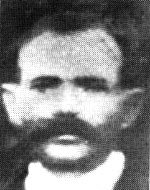Kahanoff, Ze’ev
Son of Tsherna and Uriah. He was born in 1873 in Hommel, Russia, and his parents were killed in a pogrom that took place in their city, and he joined the family of his uncle in Jerusalem, where he studied and worked. He worked in the vineyards of Ness Ziona, the orchards of the ICA and the winery in Rishon Letzion. For several years he also worked as the manager of the agricultural farm of Abdul Rahman in Wadi al-Hanin and was even a trustee. Three years after his arrival, Ze’ev was among the founders of “Nahalat Tel Aviv”. He purchased land and built his house on the street that was part of its construction. It is a Tel Aviv street founded by the Ness Ziona workers’ group according to the principle of moshav settlement. Ze’ev was also a member of the local community and was a member of several moshavim committees. In 1900 he was one of the founders and activists of the Histadrut labor federation in Palestine and was a member of its executive committee. Between 1908 and 1918 he served as chairman of the settlement committee. During the First World War, the Nili group operated in the area, and it gave it much help as it was persecuted by the Turkish authorities. At the beginning of 1918, Turkish army and police forces began to raid Jewish settlements in order to capture the members of the Nili group and the deserters from the Turkish army. Ze’ev Kahanoff was captured in Rishon Letzion and six others from Ness Ziona were sent on foot to prison in Jerusalem. In the book “Nes Tziona”, Moshe Smilansky describes the event: “All the inhabitants of the settlement accompanied the prisoners with tears and sighs of shame, as if they were accompanying the dead … and for good reason, the prisoners were shackled ascriminals.” In Jerusalem, they were imprisoned for about a month. During this period, Kahanoff was arranged for escape, but he refused to flee, fearing that those in prison would suffer. The prisoners were taken by foot to Nablus and Afula, and from there they were loaded with trains to Damascus. In Damascus, they were held in extremely poor conditions and constant starvation, and many of them fell ill with typhus and dysentery. Ze’ev also contracted these diseases and was no longer able to recover. On the 28th of Tevet (12.1.1918), he died in the military hospital in Damascus. He was brought to eternal rest in the Jewish cemetery of the Damascus community. He left a wife, three sons and a daughter. His life and his death were commemorated in “The Book of Nes Tziona,” and one of the streets in the settlement was named after his friends: “Golei Damesek Street”.
